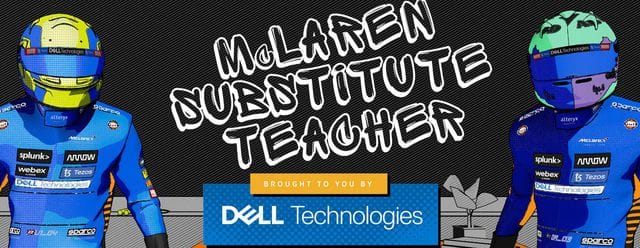
McLAREN Substitute Teacher
We've teamed up with Dell Technologies to give home schooling an F1 twist

Hands up, who wants to add a bit more excitement to learning from home?
With the support of our friends at Dell Technologies – the folks who provide the cool tech to help our cars go faster – we’ve switched up your homework, big time. We’ve ripped up the rulebook when it comes to lesson plans and brought in substitute teachers from the McLaren F1 team – and they just so happens to be some of the fastest people on the planet: F1 drivers Lando Norris and Daniel Ricciardo!
Still not convinced? Well, there’s nothing stopping you from skipping these lessons. We’re not going to put you in detention but if you do skip them, you’re going to miss out on learning how to use AI to win on and off the track, how aerodynamics make F1 cars go faster, and what materials the sport uses.
So what are you waiting for? Keep scrolling and get to class!
Series 3
Lesson 4: Climate Change

Lesson 3: Reduce, Reuse & Recycle

Lesson 2: Equality, Diversity & Inclusion
Watch Lesson 2 below. And download the race car template here.

Lesson 1: Health & wellbeing

Series 2
Lesson 5: Latency
What's it about?
Network performance.
We ask:
How does it make a difference for us in races?
Watch lesson 5 below.

Lesson 4: Materials Engineering
What's it about?
Understanding a range of materials and their properties, and how they are used in F1.
We ask:
How do we decide to use which materials where on the car and why?
Watch Lesson 4 below.

Lesson 3: Data forecasting
What's it about?
How data can help you predict the future.
We ask:
How important is it to have the right data to make decisions in Formula 1?
Watch Lesson 3 below.

Lesson 2: Aerodynamics
What's it about?
How we uses aerodynamics to make a Formula 1 car go faster.
We ask:
How do different parts of the car make contributions?
Watch Lesson 2 below. And download the race car template here.

Lesson 1: Machine Learning
What's it about?
How to use data and Artificial Intelligence to win on and off the race track.
We ask:
How do machines learn to build a better and faster F1 car?
Watch Lesson 1 below.

Series 1
Lesson 1: How to Predict the Future
What's it about?
Probabilities, and how to predict what will happen during a grand prix.
We ask:
Why is having a strategy important in F1 and in the wider world?
Watch Lesson 1 below.

Lesson 2: How to drive upside down
What's it about?
Motion and forces. We find out how an F1 car accelerates, decelerates and stays on track.
We ask:
What is slipstream? Can an F1 car drive upside down in a tunnel?
Watch Lesson 2 below.

Lesson 3: Beating an F1 driver
What's it about?
Diet, nutrition and how an F1 driver stays fit and healthy.
We ask:
What type of diet does a driver need to keep fit? Why is eating healthy and good nutrition important?
Watch Lesson 3 below.

Lesson 4: Phone a friend at 200 mph
What's it about?
Communication. How F1 engineers receive, process and communicate complex information quickly.
We ask:
How do you work effectively with all types of people?
Watch Lesson 4 below.

Lesson 5: A big bang
What's it about?
Engine efficiency. What an engine is and how they power F1 cars.
We ask:
We ask, how can we make them more efficient?
Watch Lesson 5 below.

Lesson 6: Networking?
What's it about?
Spanning trees. What is an algorithm and how do we use them?
We ask:
How can we use them to make decisions?
Watch Lesson 6 below.




